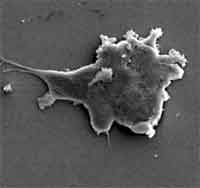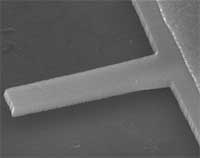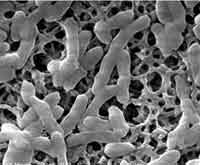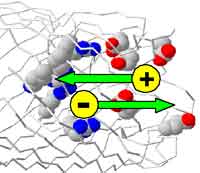Showing Spotlights 2457 - 2464 of 2838 in category All (newest first):
 Firefighters and stuntmen certainly appreciate the fire resistant capabilities of modern textiles. Going far beyond such niche use, flame retardant materials have become a major business for the chemical industry and can be found practically everywhere in modern society. If you live in a country where houses are mostly built from wood (like in the U.S.; where, on the other hand, the things that used to be wood are now plastic - like christmas trees; flame retardant ones of course) most structural timber and wood elements such as paneling are treated to make them more fire resistant. Plastic materials are replacing traditional materials like wood and metal - just look at the toys you played with and the ones your kids have today. Unfortunately, the synthetic polymeric materials we group under the term 'plastic' are flammable. To decrease their flammability they require the addition of flame-retardant chemical compounds. The plastic casings, circuit boards and cables of your computers, electrical appliances or car are flame retardant. So is practically every material in airplanes, trains and ships from the fabric of seats to every kind of plastic structure found onboard. Name any plastic product and chances are it has been made flame retardant. Conventional methods for making plastic flame retardant involve a range of not exactly harmless chemicals. Improving the flame retardancy of polymeric materials without the use of toxic chemicals could now become possible thanks to the synergistic effect of carbon nanotubes and clay.
Firefighters and stuntmen certainly appreciate the fire resistant capabilities of modern textiles. Going far beyond such niche use, flame retardant materials have become a major business for the chemical industry and can be found practically everywhere in modern society. If you live in a country where houses are mostly built from wood (like in the U.S.; where, on the other hand, the things that used to be wood are now plastic - like christmas trees; flame retardant ones of course) most structural timber and wood elements such as paneling are treated to make them more fire resistant. Plastic materials are replacing traditional materials like wood and metal - just look at the toys you played with and the ones your kids have today. Unfortunately, the synthetic polymeric materials we group under the term 'plastic' are flammable. To decrease their flammability they require the addition of flame-retardant chemical compounds. The plastic casings, circuit boards and cables of your computers, electrical appliances or car are flame retardant. So is practically every material in airplanes, trains and ships from the fabric of seats to every kind of plastic structure found onboard. Name any plastic product and chances are it has been made flame retardant. Conventional methods for making plastic flame retardant involve a range of not exactly harmless chemicals. Improving the flame retardancy of polymeric materials without the use of toxic chemicals could now become possible thanks to the synergistic effect of carbon nanotubes and clay.
Aug 30th, 2007
 Some 5,000 years ago, the megalomaniac rulers of Egypt built themselves the mothers of all tombstones - pyramids. Pyramids are the largest monuments constructed by mankind (by the way, the largest of them all, the Great Pyramid of Cholula in Mexico, has an estimated volume of 4.45 million cubic meters; which makes it almost one third larger than the Great Pyramid of Giza in Egypt; the Giza pyramid is taller, though). On the other end of the size spectrum, down to earth scientists in Germany have built some of the smallest pyramids - they are only a few hundred nanometers tall. Like their big brothers in the Arabian desert the nanopyramids' purpose is to 'entomb' something. Designed to work as a new class of microcavity optical resonator, these structures rely on internal reflection of light waves from the tilted pyramid facets to achieve strong confinement of light in all three spatial dimensions with low loss. Where the Egyptian pyramids were supposed to be a place of ascendance for the pharaoh buried inside, the German nanopyramids are 'temporary resting places' for light, giving raise to quantum optical phenomena that could provide the basis for future quantum computers.
Some 5,000 years ago, the megalomaniac rulers of Egypt built themselves the mothers of all tombstones - pyramids. Pyramids are the largest monuments constructed by mankind (by the way, the largest of them all, the Great Pyramid of Cholula in Mexico, has an estimated volume of 4.45 million cubic meters; which makes it almost one third larger than the Great Pyramid of Giza in Egypt; the Giza pyramid is taller, though). On the other end of the size spectrum, down to earth scientists in Germany have built some of the smallest pyramids - they are only a few hundred nanometers tall. Like their big brothers in the Arabian desert the nanopyramids' purpose is to 'entomb' something. Designed to work as a new class of microcavity optical resonator, these structures rely on internal reflection of light waves from the tilted pyramid facets to achieve strong confinement of light in all three spatial dimensions with low loss. Where the Egyptian pyramids were supposed to be a place of ascendance for the pharaoh buried inside, the German nanopyramids are 'temporary resting places' for light, giving raise to quantum optical phenomena that could provide the basis for future quantum computers.
Aug 29th, 2007
 In the medical field there is a huge demand for tissue regeneration technologies, which covers a wide range of potential applications in such areas as cartilage, vascular, bladder and neural regeneration. Just consider the need for bone and dental implants: Each year, almost 500,000 patients receive hip implants worldwide, about the same number need bone reconstruction due to injuries or congenital defects and 16 million Americans loose teeth and may require dental implants. The market for medical implant devices in the U.S. alone is estimated to be $23 billion per year and it is expected to grow by about 10% annually for the next few years. Unfortunately, medical implant devices have been associated with a variety of adverse reactions, including inflammation and fibrosis. It has been suggested that poor tissue integration is responsible for loosening of implants and mechanical damage to the surrounding host tissues. Based on an expanding body of biomedical nanotechnology research work, there is a growing consensus among scientists that nanostructured implant materials may have many potential advantages over existing, conventional ones. The key, as indicated in a number of findings, seems to be that physical properties of materials, especially with regard to their surface's nanostructure, affect cell attachment and eventually the tissue response to the implant. Although nanotopography mediated cell responses have been shown in previous work, the mechanism of these responses is mostly undetermined. New research has now been conducted to determine the influence of nanopore size on cellular responses. Interestingly, these studies have revealed that larger nanopores (200 nm) trigger DNA replication and cell proliferation via various signal transduction pathways.
In the medical field there is a huge demand for tissue regeneration technologies, which covers a wide range of potential applications in such areas as cartilage, vascular, bladder and neural regeneration. Just consider the need for bone and dental implants: Each year, almost 500,000 patients receive hip implants worldwide, about the same number need bone reconstruction due to injuries or congenital defects and 16 million Americans loose teeth and may require dental implants. The market for medical implant devices in the U.S. alone is estimated to be $23 billion per year and it is expected to grow by about 10% annually for the next few years. Unfortunately, medical implant devices have been associated with a variety of adverse reactions, including inflammation and fibrosis. It has been suggested that poor tissue integration is responsible for loosening of implants and mechanical damage to the surrounding host tissues. Based on an expanding body of biomedical nanotechnology research work, there is a growing consensus among scientists that nanostructured implant materials may have many potential advantages over existing, conventional ones. The key, as indicated in a number of findings, seems to be that physical properties of materials, especially with regard to their surface's nanostructure, affect cell attachment and eventually the tissue response to the implant. Although nanotopography mediated cell responses have been shown in previous work, the mechanism of these responses is mostly undetermined. New research has now been conducted to determine the influence of nanopore size on cellular responses. Interestingly, these studies have revealed that larger nanopores (200 nm) trigger DNA replication and cell proliferation via various signal transduction pathways.
Aug 28th, 2007
 In his famous 1959 speech "Plenty of Room at the Bottom", Richard Feynman offered a prize of $1000 "to the first guy who makes an operating electric motor - a rotating electric motor which can be controlled from the outside and, not counting the lead-in wires, is only 1/64 inch cube." Feynman had hoped his reward would stimulate some new fabrication technology but he was quite consternated when one year later, Bill McLellan, using amateur radio skills, built the motor with his hands using tweezers and a microscope (and many, many hours of fiddling around). McLellan's 2000 rpm motor weighed 250 micrograms and consisted of 13 parts. In the almost 50 years since, not only has the field of microelectromechanical systems (MEMS) caught up with Feynman's bet and achieved commercial production capabilities of motors many times smaller than McLellan's, but researchers have begun exploring another level of miniaturization - nanoelectromechanical systems (NEMS). Efficient actuation, the creation of mechanical motion by converting various forms of energy to rotating or linear mechanical energy, is an important - and today still frustrating - issue in designing NEMS. Research on building functional nanoscale electromechanical systems is well underway, as just demonstrated with another achievement by scientists at Caltech - the place where Feynman gave his speech and McLellan's motor still is on display.
In his famous 1959 speech "Plenty of Room at the Bottom", Richard Feynman offered a prize of $1000 "to the first guy who makes an operating electric motor - a rotating electric motor which can be controlled from the outside and, not counting the lead-in wires, is only 1/64 inch cube." Feynman had hoped his reward would stimulate some new fabrication technology but he was quite consternated when one year later, Bill McLellan, using amateur radio skills, built the motor with his hands using tweezers and a microscope (and many, many hours of fiddling around). McLellan's 2000 rpm motor weighed 250 micrograms and consisted of 13 parts. In the almost 50 years since, not only has the field of microelectromechanical systems (MEMS) caught up with Feynman's bet and achieved commercial production capabilities of motors many times smaller than McLellan's, but researchers have begun exploring another level of miniaturization - nanoelectromechanical systems (NEMS). Efficient actuation, the creation of mechanical motion by converting various forms of energy to rotating or linear mechanical energy, is an important - and today still frustrating - issue in designing NEMS. Research on building functional nanoscale electromechanical systems is well underway, as just demonstrated with another achievement by scientists at Caltech - the place where Feynman gave his speech and McLellan's motor still is on display.
Aug 27th, 2007
 The fight against infections is as old as civilization. Silver, for instance, had already been recognized in ancient Greece and Rome for its infection-fighting properties and it has a long and intriguing history as an antibiotic in human health care. Modern day pharmaceutical companies developed powerful antibiotics - which also happen to be much more profitable than just plain old silver - an apparent high-tech solution to get nasty microbes such as bacteria under control. In the 1950s, penicillin was so successful that the U.S. surgeon general at the time, William H. Stewart, declared it was "time to close the book on infectious diseases, declare the war against pestilence won." Boy, was he wrong! These days, the U.S. Centers for Disease Control and Prevention (CDC) estimates that the infections acquired in hospitals alone (of all places! it's 2007 and we can't even make our hospitals safe - how scary is that?) affect approximately 2 million persons annually. In the U.S., between 44,000 and 98,000 people die every year from infections they picked up in hospitals. As our antibiotics become more and more ineffective researchers have begun to re-evaluate old antimicrobial substances such as silver. Antimicrobial nano-silver applications have become a very popular early commercial nanotechnology product. Researchers have now made a first step to add carbon nanotubes to our microbe-killing arsenal.
The fight against infections is as old as civilization. Silver, for instance, had already been recognized in ancient Greece and Rome for its infection-fighting properties and it has a long and intriguing history as an antibiotic in human health care. Modern day pharmaceutical companies developed powerful antibiotics - which also happen to be much more profitable than just plain old silver - an apparent high-tech solution to get nasty microbes such as bacteria under control. In the 1950s, penicillin was so successful that the U.S. surgeon general at the time, William H. Stewart, declared it was "time to close the book on infectious diseases, declare the war against pestilence won." Boy, was he wrong! These days, the U.S. Centers for Disease Control and Prevention (CDC) estimates that the infections acquired in hospitals alone (of all places! it's 2007 and we can't even make our hospitals safe - how scary is that?) affect approximately 2 million persons annually. In the U.S., between 44,000 and 98,000 people die every year from infections they picked up in hospitals. As our antibiotics become more and more ineffective researchers have begun to re-evaluate old antimicrobial substances such as silver. Antimicrobial nano-silver applications have become a very popular early commercial nanotechnology product. Researchers have now made a first step to add carbon nanotubes to our microbe-killing arsenal.
Aug 24th, 2007
 There you are - a romantic dinner for two, soft jazz music in the background, exquisite French cuisine served on finest porcelain. You are sniffing that 1986 Bordeaux you kept for this special occasion. The expensive floral bouquet that is the centerpiece of the table is warmly lit by several candles. "Wait!" you think, "wouldn't the soot from these candles make a great source of fluorescent carbon nanoparticles?" Or so works the mind of a nanoscientist. This is why they make great discoveries in nanotechnology while you and I just waste a few hours on dinner. Researchers actually have just demonstrated that fluorescent nanoparticles can be prepared from a common carbon source - candle soot. The whole process is so simple it could be carried out in a freshman chemical laboratory. So chances are the dinner actually was a midnight snack over pizza and diet coke, the music was Talib Kweli, and the mood was decidedly unromantic.
There you are - a romantic dinner for two, soft jazz music in the background, exquisite French cuisine served on finest porcelain. You are sniffing that 1986 Bordeaux you kept for this special occasion. The expensive floral bouquet that is the centerpiece of the table is warmly lit by several candles. "Wait!" you think, "wouldn't the soot from these candles make a great source of fluorescent carbon nanoparticles?" Or so works the mind of a nanoscientist. This is why they make great discoveries in nanotechnology while you and I just waste a few hours on dinner. Researchers actually have just demonstrated that fluorescent nanoparticles can be prepared from a common carbon source - candle soot. The whole process is so simple it could be carried out in a freshman chemical laboratory. So chances are the dinner actually was a midnight snack over pizza and diet coke, the music was Talib Kweli, and the mood was decidedly unromantic.
Aug 23rd, 2007
 Flawed government thinking is driving a rapid expansion in the military influence over science and technology, says a new briefing from Scientists for Global Responsibility (SGR). US government spending on military research and development is soaring (up 57% since 2001), while the UK government has rolled out two new military technology strategies in the last two years. Factors such as these are contributing to an expansion of military involvement in US and UK universities. As far as nanotechnology is concerned, and as we have reported here before, the military is the largest investor in the U.S. Nanotechnology Initiative (NNI). The Department of Defense (DoD)'s share of the $6.6 billion NNI budget since the program's inception is over 30%, or $2 billion. While a part of this military research spend goes to the internal laboratories of the various parts of the armed services (navy, army, air force) and DARPA, another parts goes to universities as research grants or as part of MURI (Multi-University Research Initiative). The SGR, in its new briefing, documents how government funding for military research and development dwarfs that spent on social and environmental programs across the industrialized world. The group highlights how the military involvement in research continues to support a narrow weapons-based security agenda. SRG argues that this marginalizes a broader approach to security, which would give much greater priority to supporting conflict prevention by helping to address the roots of conflict. As part of this case, they point out how research that aims to help tackle poverty, climate change and ill-health - and thus help to provide basic security for human populations - is under-funded compared with military research.
Flawed government thinking is driving a rapid expansion in the military influence over science and technology, says a new briefing from Scientists for Global Responsibility (SGR). US government spending on military research and development is soaring (up 57% since 2001), while the UK government has rolled out two new military technology strategies in the last two years. Factors such as these are contributing to an expansion of military involvement in US and UK universities. As far as nanotechnology is concerned, and as we have reported here before, the military is the largest investor in the U.S. Nanotechnology Initiative (NNI). The Department of Defense (DoD)'s share of the $6.6 billion NNI budget since the program's inception is over 30%, or $2 billion. While a part of this military research spend goes to the internal laboratories of the various parts of the armed services (navy, army, air force) and DARPA, another parts goes to universities as research grants or as part of MURI (Multi-University Research Initiative). The SGR, in its new briefing, documents how government funding for military research and development dwarfs that spent on social and environmental programs across the industrialized world. The group highlights how the military involvement in research continues to support a narrow weapons-based security agenda. SRG argues that this marginalizes a broader approach to security, which would give much greater priority to supporting conflict prevention by helping to address the roots of conflict. As part of this case, they point out how research that aims to help tackle poverty, climate change and ill-health - and thus help to provide basic security for human populations - is under-funded compared with military research.
Aug 22nd, 2007
 Ion channels are proteins with a hole down their middle that are the gatekeepers for cells. Ion channels control an enormous range of biological function in health and disease. In channels with a diameter greater than 100 nm, the interaction between the channel wall and electrolyte solution hardly affects the flow of ions. When the channel diameter enters the the below-10 nm range, things change dramatically, however. Then, the interaction between the solution and channel wall starts to dominate ionic flow and ion transport through such narrow, nano-scaled channels is dominated by electrostatics. The same is true for biological ion channels where charged amino residues in the selectivity filter determine the ionic flow through the channel, along with the dielectric charge on the channel wall, and the concentrations and potential in the bulk solution. The role electrostatics play in biological pores has been confirmed by numerous mutation studies where amino acids residues in the selectivity filter were replaced by others. Ion channels have simple enough structure that they can be analyzed with the usual tools of physical science. With that analysis in hand, researchers are trying to design practical machines that use ion channels. By exploiting the electrostatics in nanochannels a group of US and Dutch scientists managed to make a diode. Like a solid-state diode allows current flow in one direction, the ionic equivalent they designed can be used to direct the flow of ions across a membrane that separates two electrolyte solutions. Now that they know how to manipulate the ion selectivity in these devices, they hope to be able one day to selectively amplify currents carried by individual chemical species - a stunning prospect for molecular nanoelectronics.
Ion channels are proteins with a hole down their middle that are the gatekeepers for cells. Ion channels control an enormous range of biological function in health and disease. In channels with a diameter greater than 100 nm, the interaction between the channel wall and electrolyte solution hardly affects the flow of ions. When the channel diameter enters the the below-10 nm range, things change dramatically, however. Then, the interaction between the solution and channel wall starts to dominate ionic flow and ion transport through such narrow, nano-scaled channels is dominated by electrostatics. The same is true for biological ion channels where charged amino residues in the selectivity filter determine the ionic flow through the channel, along with the dielectric charge on the channel wall, and the concentrations and potential in the bulk solution. The role electrostatics play in biological pores has been confirmed by numerous mutation studies where amino acids residues in the selectivity filter were replaced by others. Ion channels have simple enough structure that they can be analyzed with the usual tools of physical science. With that analysis in hand, researchers are trying to design practical machines that use ion channels. By exploiting the electrostatics in nanochannels a group of US and Dutch scientists managed to make a diode. Like a solid-state diode allows current flow in one direction, the ionic equivalent they designed can be used to direct the flow of ions across a membrane that separates two electrolyte solutions. Now that they know how to manipulate the ion selectivity in these devices, they hope to be able one day to selectively amplify currents carried by individual chemical species - a stunning prospect for molecular nanoelectronics.
Aug 21st, 2007
 Firefighters and stuntmen certainly appreciate the fire resistant capabilities of modern textiles. Going far beyond such niche use, flame retardant materials have become a major business for the chemical industry and can be found practically everywhere in modern society. If you live in a country where houses are mostly built from wood (like in the U.S.; where, on the other hand, the things that used to be wood are now plastic - like christmas trees; flame retardant ones of course) most structural timber and wood elements such as paneling are treated to make them more fire resistant. Plastic materials are replacing traditional materials like wood and metal - just look at the toys you played with and the ones your kids have today. Unfortunately, the synthetic polymeric materials we group under the term 'plastic' are flammable. To decrease their flammability they require the addition of flame-retardant chemical compounds. The plastic casings, circuit boards and cables of your computers, electrical appliances or car are flame retardant. So is practically every material in airplanes, trains and ships from the fabric of seats to every kind of plastic structure found onboard. Name any plastic product and chances are it has been made flame retardant. Conventional methods for making plastic flame retardant involve a range of not exactly harmless chemicals. Improving the flame retardancy of polymeric materials without the use of toxic chemicals could now become possible thanks to the synergistic effect of carbon nanotubes and clay.
Firefighters and stuntmen certainly appreciate the fire resistant capabilities of modern textiles. Going far beyond such niche use, flame retardant materials have become a major business for the chemical industry and can be found practically everywhere in modern society. If you live in a country where houses are mostly built from wood (like in the U.S.; where, on the other hand, the things that used to be wood are now plastic - like christmas trees; flame retardant ones of course) most structural timber and wood elements such as paneling are treated to make them more fire resistant. Plastic materials are replacing traditional materials like wood and metal - just look at the toys you played with and the ones your kids have today. Unfortunately, the synthetic polymeric materials we group under the term 'plastic' are flammable. To decrease their flammability they require the addition of flame-retardant chemical compounds. The plastic casings, circuit boards and cables of your computers, electrical appliances or car are flame retardant. So is practically every material in airplanes, trains and ships from the fabric of seats to every kind of plastic structure found onboard. Name any plastic product and chances are it has been made flame retardant. Conventional methods for making plastic flame retardant involve a range of not exactly harmless chemicals. Improving the flame retardancy of polymeric materials without the use of toxic chemicals could now become possible thanks to the synergistic effect of carbon nanotubes and clay.
 Subscribe to our Nanotechnology Spotlight feed
Subscribe to our Nanotechnology Spotlight feed





